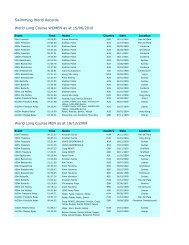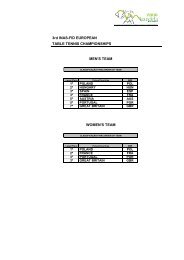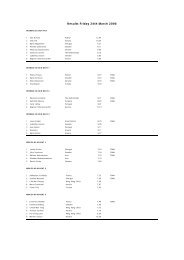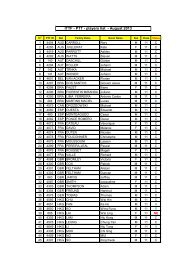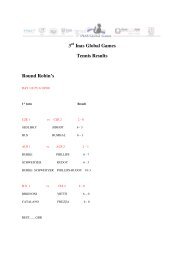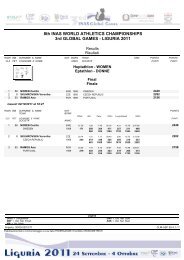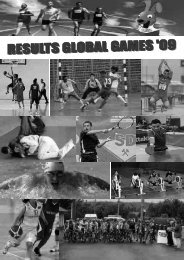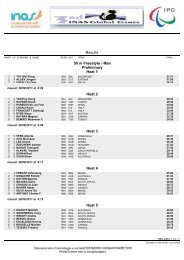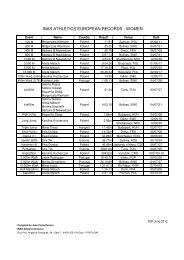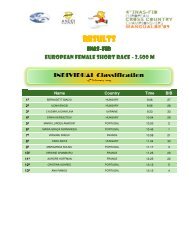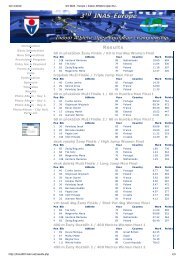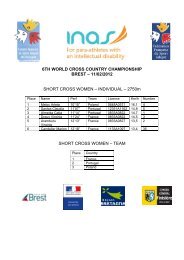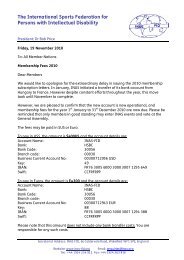SECTION 7: SPORT & EVENT SPECIFICATIONS - Inas
SECTION 7: SPORT & EVENT SPECIFICATIONS - Inas
SECTION 7: SPORT & EVENT SPECIFICATIONS - Inas
Create successful ePaper yourself
Turn your PDF publications into a flip-book with our unique Google optimized e-Paper software.
<strong>SECTION</strong> 7: <strong>SPORT</strong> & <strong>EVENT</strong> <strong>SPECIFICATIONS</strong><br />
7.11 <strong>SPORT</strong> <strong>SPECIFICATIONS</strong> – ALPINE SKIING<br />
1 INTRODUCTION<br />
1.1 The <strong>Inas</strong> Alpine Skiing Championships will be governed by the rules<br />
of FIS with the approved variations by <strong>Inas</strong>.<br />
2 START<br />
2.1 In all the competitions, in the first run of the Giant and Special<br />
Slalom, the competitors will come down according to their age,<br />
random, following the competition schedule; while in the second<br />
run, the competitors will come down, always according to their age,<br />
but starting from the one who obtained the best time in the first<br />
run. The sum of the times got in both runs will make the final time<br />
and the resulting placing in the ranking list.<br />
2.2 In the downhill competition, being made up of a single run, the<br />
competitors will come down according to their age, random,<br />
following the competition schedule.<br />
3 <strong>EVENT</strong>S<br />
3.1 Special Slalom<br />
3.2 The main characteristics of the special slalom are the following:<br />
a) For each class there is a course on a relatively steady slope so<br />
as to enable the skiers to come down in a cadenced way<br />
(right/left).<br />
b) The competition will take place with a “single pole”<br />
c) The course should enable the athletes to make a steady<br />
movement (turns), without long pauses (between 0,75 and 1,5<br />
sec.) between one and the following.<br />
d) The competition is divided into 2 runs, the final placement will<br />
depend on the sum of the 2 times.<br />
e) See the enclosed table for the technical details.<br />
3.3 Giant Slalom<br />
3.4 The main characteristics of the giant slalom are the following:<br />
a) The course is on a relatively steady slope, with open gates put<br />
in a way that athletes have from 1.5 to 2.5 seconds between a<br />
turn and another one. The athletes should come down<br />
alternating brief moments of sliding with a suitable speed and<br />
turns.<br />
b) The competition is divided into 2 runs, the final placement will<br />
depend on the sum of the 2 times.<br />
c) See the enclosed table for the technical details.<br />
3.5 Downhill ( Super Giant Slalom )<br />
3.6 These competitions for athletes with an intellectual disability are<br />
different from those run by FIS regulations.<br />
Updated May 2011<br />
Page 1 of 3
<strong>SECTION</strong> 7: <strong>SPORT</strong> & <strong>EVENT</strong> <strong>SPECIFICATIONS</strong><br />
7.11 <strong>SPORT</strong> <strong>SPECIFICATIONS</strong> – ALPINE SKIING<br />
3.7 In the downhill there is a cadenced course with several wide turns.<br />
The time between a gate and the following one should not exceed<br />
2.5 – 3 seconds, so that the athlete can control his/her speed in<br />
every situation.<br />
3.8 The downhill or Super Giant Slalom competition is performed in a<br />
single run.<br />
3.9 See the enclosed table for the technical details.<br />
3.10 The downhill competition consists of a single run, while the Special<br />
and Giant Slalom ones are performed in 2 runs where the sum of the<br />
2 times decides the final ranking.<br />
3.11 A crash helmet approved by FIS is compulsory for all competitions<br />
and athletes.<br />
3.12 The gate judge is responsible for the right passing of the athlete.<br />
4 COURSES<br />
4.1 All the courses for <strong>Inas</strong> Alpine Skiing competitions should be<br />
prepared in a way that, if possible, the first gate forces the<br />
competitors to change their direction from a diagonal line from the<br />
left.<br />
4.2 All the gates should be made up of an internal pole and an external<br />
one (except for the Special Slalom competition that takes place with<br />
a single pole). Both poles of a single gate should be of the same<br />
colour, while the gates should be of alternate colours. Furthermore,<br />
the persons responsible for the preparation of the courses should<br />
prepare them in order to allow a constant rhythm for the<br />
competitors.<br />
4.3 A Technical Delegate, who is member of <strong>Inas</strong>, marks the course for<br />
each competition together with local assistants. He has the<br />
responsibility to check if the course complies with the regulations.<br />
4.4 All the people in charge of the preparation of the course should<br />
avoid using a combination of vertical, slanting or bent gates. All the<br />
gates of the course must be placed in order to be all “open” (that is,<br />
if we draw a line connecting the internal poles and the external ones<br />
of each gate, they should be perpendicular to the line that forms the<br />
general downhill line of the course, from about the starting gate to<br />
the finish one).<br />
4.5 Starting area: all the starting areas must be flat, so as to allow the<br />
athletes to wait in a relaxed way, without effort. Such area should<br />
be easily accessible and without other skiers.<br />
Updated May 2011<br />
Page 2 of 3
<strong>SECTION</strong> 7: <strong>SPORT</strong> & <strong>EVENT</strong> <strong>SPECIFICATIONS</strong><br />
7.11 <strong>SPORT</strong> <strong>SPECIFICATIONS</strong> – ALPINE SKIING<br />
Competition Min./max level difference<br />
of the gates<br />
Min./max Min./max<br />
slope<br />
Min.<br />
width<br />
Special 60 – 180 m. 15 – 45 20 – 45 % 25 m.<br />
slalom<br />
Giant slalom 80 – 350 m. 15 – 40 20 – 45 % 30 m.<br />
Downhill<br />
(SG)<br />
100 – 500 m. 10 – 30 15 – 28 % 30 m.<br />
4.6 For each missing rule will apply international rules FIS<br />
Updated May 2011<br />
Page 3 of 3



